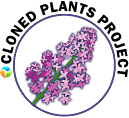Project Overview:

Your observations of dogwood life cycle events can enhance the decades of lilac phenology records that have been collected across the U.S. as part of the Cloned Plants Project.
You're invited to participate in the Cloned and Native Flowering Dogwoods Campaign by obtaining a cloned dogwood (Cornus florida 'Appalachian Spring') and reporting phenology observations via Nature's Notebook. You can also participate by tracking a native flowering dogwood (Cornus florida) that is already established in your yard.
Comparing the phenology of this species with that of cloned dogwoods enhances our understanding of genetic and environmental influences on the plants. Observations of the common and cloned species at the same location are especially valuable for untangling these mysteries.
WHY CLONES?
A lilac in New York blooms later than a lilac in Virginia. Why? One way to better understand the timing of spring phenology is by planting genetically identical plants, or clones, in different locations, and then to observe when they leaf out and flower. When observations are made on cloned plants, you can know with confidence that differences in the timing of flowering and leafing between different individuals is due to differences in local environmental conditions. Learn more about this research.
Your data inform the influence of genetic and environmental variation in dogwood flowering. In 2021, a number of dogwood observers contributed leaf samples from their dogwood trees for an NSF-funded project led by Dr. James Leebens-Mack of the University of Georgia. The samples will be used to test the role of genes and environmental factors in the timing of leaves, flowers, colored leaves, leaf fall, and more. Ultimately, the team hopes to understand the impact of weather and climate on dogwoods and other flowering plants. Thank you for participating in this effort!
SIGN UP FOR Cloned and Native Flowering Dogwoods MESSAGES!
You will receive messages full of findings, observation tips, and campaign-specific opportunities. Don't miss out!
How to participate...
1. Obtain or select your plants. Purchase a cloned dogwood (Cornus florida "Appalachian Spring") from a local nursery.
If you prefer to track plants which are already established at your site, we also welcome observations on native flowering dogwood (Cornus florida).
2. Join Nature's Notebook. If you haven't already, create a Nature's Notebook account. If you need more details on getting started, take the Observer Certification Course at learning.usanpn.org.
If you are tracking a cloned lilac, make sure to select Cornus florida "Appalachian Spring" when adding the plant to your site.
3. Observe your plant(s). Report what you see (yes/no/not sure) on your plant periodically following the instructions for flowering dogwoods. We encourage you to observe your plant(s) 2-4 times a week, especially in the spring, when things are changing rapidly. However, we welcome any observations you can contribute.
We are especially interested in the following phenophases, although you are welcome to track all of the phenophases for this species. We have also included some photos to help you identify some of the more tricky phenophases:
How do I tell a leaf bud from a flower bud? Leaf buds (left photo) and flower buds (right photo) can be tricky to identify. If you think you have misidentified a flower or leaf bud, you can correct your submitted observations. Learn more here. Also, remember that the "flowers" you are looking for are actually the small yellow/green flowers inside the large white bracts. In dogwoods, flower buds generally start to open before leaf buds.
 |
 |
5. Report your observations. Periodically log into your Nature's Notebook account and transfer your observations from your paper data sheet into the online reporting system. Alternatively, you can enter your observations directly using the Nature's Notebook app.
The Dogwood Genome Project

Dogwoods have long been cultivated for their showy flowers and fine-grained wood. Recently, the market value of dogwoods has increased as demand for woody ornamentals grows in the U.S. To advance the breeding potential of these economically and culturally important trees and shrubs, scientists can use genetics and advanced genomics to study critical agronomic traits such as flowering time, flower characteristics, disease resistance and stress responses. The Dogwood Genome Project, led by researchers from University of Georgia, University of Tennessee, and North Carolina State University and funded by the National Science Foundation, is generating a reference genome sequence for the flowering dogwood clone (Cornus florida 'Appalachian Spring').
The Dogwood Genome Project will use phenology observations collected through Nature's Notebook for both native flowering dogwoods and cloned dogwoods by investigating the genes that may be influencing the timing of leaf-out, flowering and leaf-fall. Understanding the genetic basis of these phenological traits will help breeders develop varieties that are best suited for particular growing zones.



